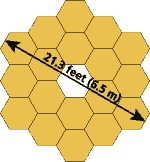Figure: The James Webb Space Telescope
Artist impression of the JWST flying in space at the Lagrange point L2.

Primary Light-Gathering Mirror
6.5 m at its widest point
A total area of 25 m2

Wavelength Range
Visible to mid-infrared (0.6 to 27+ micrometers)
Mission Lifetime
5 - 10 years
Instruments
Near-infrared camera (0.6 to 5 micrometers)
Multi-object near-infrared spectrometer (0.8 - 5 micrometers)
Mid-infrared camera/spectrometer (5 to 27+ micrometers)
Tunable filter camera (1.25 - 5 micrometers)
Operating Temperature
40 Kelvin (-233.3 oCelsius)
Payload Mass
About 6,800 kg
Launch Vehicle
Ariane 5
Orbit
940,000 miles (1.5 million km) from Earth at the Second Lagrange Point (L2)
Second Lagrange Point (L2)
The mathematician Joseph-Louis Lagrange determined that there are five points around two orbiting masses where a third, smaller mass can orbit at a constant distance from the larger masses. At those points, the gravitational pull of the large masses are balanced by the centripetal force necessary to rotate with the objects. JWST will be placed at the Second Lagrange Point, or L2. Normally, an object circling the Sun beyond the Earth would take more than a year to finish an orbit. But the balance of forces at the Second Lagrange Point means JWST will be able to keep up with the Earth as it orbits the Sun. JWST will remain at a fairly constant distance from the Earth throughout the year with only small maneuvers necessary.
Credit: NASA Goddard Space Flight Center
http://jwstsite.stsci.edu/gallery/telescope.shtml
Quick Facts from:
http://jwstsite.stsci.edu/telescope/facts_.and._figures/quick_facts.shtml

